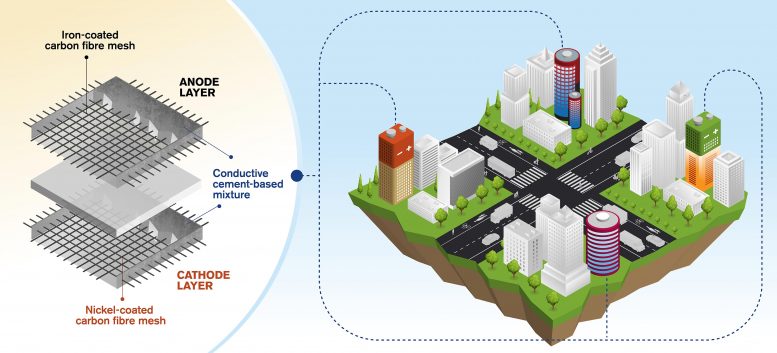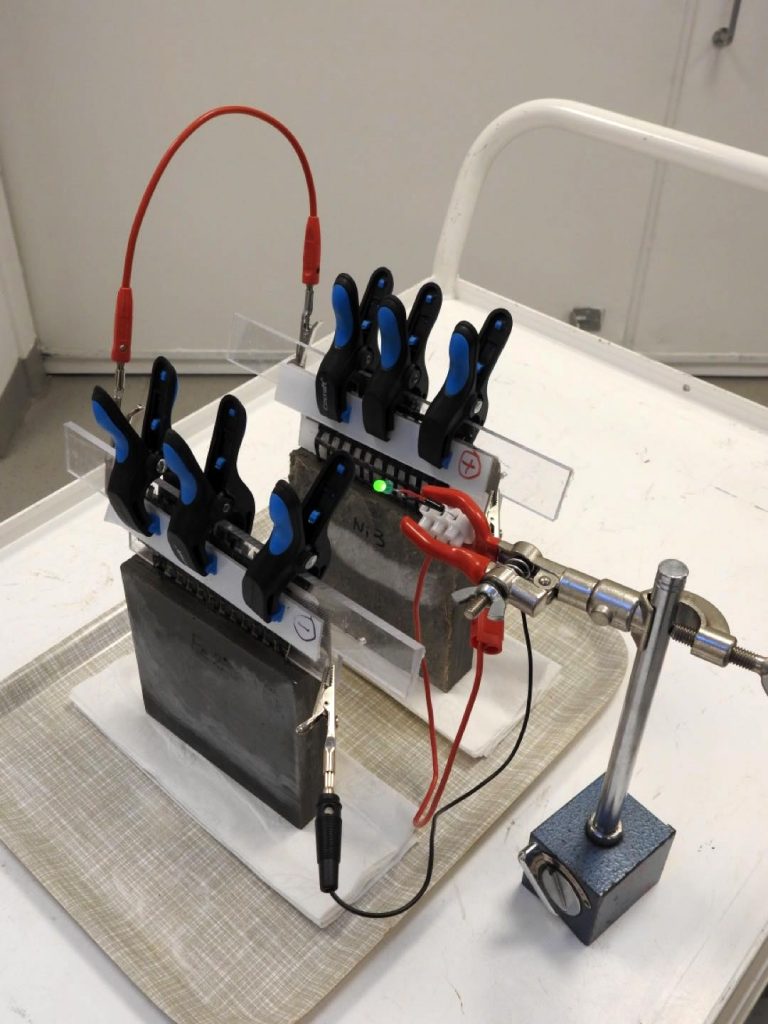
Posted on 05/18/2021 8:09:13 AM PDT by Red Badger

Imagine an entire twenty-story concrete building that can store energy like a giant battery. Thanks to unique research from Chalmers University of Technology, Sweden, such a vision could someday be a reality. Researchers from the Department of Architecture and Civil Engineering recently published an article outlining a new concept for rechargeable batteries — made of cement.
The ever-growing need for sustainable building materials poses great challenges for researchers. Doctor Emma Zhang, formerly of Chalmers University of Technology, Sweden, joined Professor Luping Tang’s research group several years ago to search for the building materials of the future. Together they have now succeeded in developing a world-first concept for a rechargeable cement-based battery.
The concept involves first a cement-based mixture, with small amounts of short carbon fibers added to increase the conductivity and flexural toughness. Then, embedded within the mixture is a metal-coated carbon-fiber mesh — iron for the anode, and nickel for the cathode. After much experimentation, this is the prototype which the researchers now present.

A prototype of the battery developed by the researchers. Credit: Chalmers University of Technology
“Results from earlier studies investigating concrete battery technology showed very low performance, so we realized we had to think out of the box, to come up with another way to produce the electrode. This particular idea that we have developed — which is also rechargeable — has never been explored before. Now we have proof of concept at lab scale,” Emma Zhang explains.
Luping Tang and Emma Zhang’s research has produced a rechargeable cement-based battery with an average energy density of 7 Watthours per square meter (or 0.8 Watthours per liter). Energy density is used to express the capacity of the battery, and a modest estimate is that the performance of the new Chalmers battery could be more than ten times that of earlier attempts at concrete batteries. The energy density is still low in comparison to commercial batteries, but this limitation could be overcome thanks to the huge volume at which the battery could be constructed when used in buildings.
A potential key to solving energy storage issues The fact that the battery is rechargeable is its most important quality, and the possibilities for utilization if the concept is further developed and commercialized are almost staggering. Energy storage is an obvious possiblity, monitoring is another. The researchers see applications that could range from powering LEDs, providing 4G connections in remote areas, or cathodic protection against corrosion in concrete infrastructure.
“It could also be coupled with solar cell panels for example, to provide electricity and become the energy source for monitoring systems in highways or bridges, where sensors operated by a concrete battery could detect cracking or corrosion,” suggests Emma Zhang.
The concept of using structures and buildings in this way could be revolutionary, because it would offer an alternative solution to the energy crisis, by providing a large volume of energy storage.
Concrete, which is formed by mixing cement with other ingredients, is the world’s most commonly used building material. From a sustainability perspective, it is far from ideal, but the potential to add functionality to it could offer a new dimension. Emma Zhang comments:
“We have a vision that in the future this technology could allow for whole sections of multi-story buildings made of functional concrete. Considering that any concrete surface could have a layer of this electrode embedded, we are talking about enormous volumes of functional concrete.”
Challenges remain with service-life aspects The idea is still at a very early stage. The technical questions remaining to be solved before commercialization of the technique can be a reality include extending the service life of the battery, and the development of recycling techniques. “Since concrete infrastructure is usually built to last fifty or even a hundred years, the batteries would need to be refined to match this, or to be easier to exchange and recycle when their service life is over. For now, this offers a major challenge from a technical point of view,” says Emma Zhang.
But the researchers are hopeful that their innovation has a lot to offer. “We are convinced this concept makes for a great contribution to allowing future building materials to have additional functions such as renewable energy sources,” concludes Luping Tang.
Reference: “Rechargeable Concrete Battery” by by Emma Qingnan Zhang and Luping Tang, 9 March 2021, Buildings. DOI: 10.3390/buildings11030103
The research project was funded by the Swedish Energy Agency (Energimyndigheten).
More technical information about the rechargeable cement-based battery
The researchers developed a prototype for a rechargeable cement-based battery, with an average energy density of 7 Wh/m2 (or 0.8 Wh/L) during six charge and discharge cycles. They tested several combinations for the electrodes, and found that an iron anode, and a nickel-based oxide cathode yielded the best results. The conductivity of the cement-based mixture for the electrolyte was increased by adding short carbon fibers, experimenting with different ratios to find an optimal mixture of around 0.5% carbon fibre.
Oh yeah?
Pyramids were batteries, according to various people who study these things. You’ve all heard about that, yes?
So many links out there, if anyone is inclined to leave politics behind today and go in search of ancient aliens. Fun stuff for distraction.
both lye and concrete are acid and caustic but lye is not Portland cement.
Rebar is attacked by chemical processes as it ages inside reinforced concrete. That is why bridges are built with epoxy coated rebar. Some electrical charging is sometimes applied to bridge reinforcement to counteract ion transfer.

Another one of these experiments that if were put into actual practice and a building is constructed, what could possibly go wrong?
I imagine such a building would be like a Faraday cage. There would be no risk to those inside. However, passing between inside and outside could be risky; doorways would have to be covered with non-conductive materials.
What could possibly go wrong with a huge, multi-story cement building, charged with a zillion volts? Or is it watts?
That's news to me too. I thought that once concrete sets, its chemical composition has changed. It can't be ground down to make into concrete again.
I liked it also.
Although I noticed that the Freddy character reminded me of the Griffin character in MIB 3. Probably a casting decision but it does seem funny.
It can only be crushed and used as a course aggregate. It will still will need cement and sand to make is into concrete.
And the tinfoil hat concession would able to profit from all portions of the spectrum as well.
Most early stage research never advances to a stage where it is commercially viable. This has been my experience in medical research, and I assume the same principle applies in other areas of research.
In the medical world, I've seen some truly astounding technologies that will never reach clinical use. Imagine being able to stop an epileptic seizure by shining a light into the brain. It can be done in lab animals, but I don't think we'll ever see that used in human patients.
be back after lunch to read, red
thanx for posting this
The cathode will erode and the anode with build up material. That would be unfortunate.
So you are on the 20th floor and it has a short circuit?
“Imagine an entire twenty-story concrete building that can store energy like a giant battery.”
Imagine “catastrophic discharge”...


"Results from earlier studies investigating concrete battery technology showed very low performance, so we realised we had to think out of the box, to come up with another way to produce the electrode. This particular idea that we have developed - which is also rechargeable - has never been explored before. Now we have proof of concept at lab scale," explains Emma Zhang, Doctor, formerly of the Department of Architecture and Civil Engineering, Chalmers University of Technology, now Senior Development Scientist at Delta of Sweden "We are convinced this concept makes for a great contribution to allowing future building materials to have additional functions such as renewable energy sources," says Luping Tang, Professor at the Department of Architecture and Civil Engineering, Chalmers University of Technology
if the building is built in Watts, will it survive the next round of BLM protests?

Sleeping in a battery has to be as safe as sleeping on an x-ray machine what could go wrong.
Disclaimer: Opinions posted on Free Republic are those of the individual posters and do not necessarily represent the opinion of Free Republic or its management. All materials posted herein are protected by copyright law and the exemption for fair use of copyrighted works.